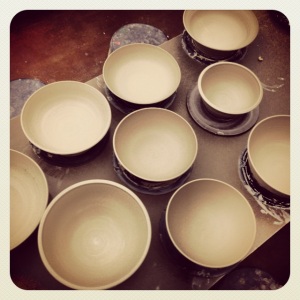Yesterday was my idea of a perfect Saturday.
I arrived at the studio early, and spent a couple of hours by myself, mixing glazes, recycling clay, loading and unloading kilns, and puttering around the space. I finished one audiobook on my headphones, and started another.
Then my friend Jon arrived, and we spent a few more hours throwing bowls together. The bowls were larger than I typically have time for during the fast-paced school day – 6-10 pounds each. We worked mostly in companionable silence, occasionally swapping stories or seeking each other’s advice on the pieces we were making.
Jon and I have been friends for over a decade now. We met while working together at a summer program for gifted teens, where he taught ceramics and I hung out around the studio as often as my admin gig would allow. I’ve admired his artistic talent, determination, and skill as a teacher for as long as I’ve known him. In fact, I followed his path to teaching, a little unsteady and unsure of myself as I worked through the same graduate program and some similar career steps. He’s been a sounding wall for me while I’ve worked through difficult questions. He’s taught some of my students over the years – in person, and through stories that I use in my own teaching.
Jon taught me how to lift a wall. For a long time, I made pots that looked and felt like bricks. He taught me that it was worth the risk to reach for that last pull, the one that would make the vessel float. I remember watching him throw a vessel over three feet tall on the wheel, on a Sunday morning at the summer program, and feeling strangely certain that this was my future. Jon taught me how to curve the inside of a bowl. He taught me that the inside, in fact, was the most important part of a bowl. When he throws, he is relentless about this curve, stretching the walls of his bowls open and down to reach the curve’s maximum fluidity. It took me a long time to learn this, but now this ‘stretch’ is one of my favorite parts of throwing.
It’s only in the last few years that I’ve noticed that we are working more as colleagues, instead of mentor and grasshopper. He’s invited me to judge an art show at his school later this week – I’m humbled and a little overwhelmed. We swap lesson plans and share project ideas now. We seek each other’s advice on challenges at work and sometimes in life. Often, we call each other out on habits. Occasionally, we finish each other’s sentences.
When we looked at our bowls laid out on the table yesterday, he commented that he couldn’t tell the difference between our pieces. I shrugged this off – I could tell the difference. His pots were more graceful, a little larger and looser than mine. But then, this morning, when I stopped by the studio to flip and wrap the pieces, I lost track of whose work was whose. I paused. I smiled.
His is one of the most constructive and rewarding friendships I’ve ever had.
—
One of the biggest similarities between pottery and relationships is metaphor. I suppose that one of the reasons I reference Chris Staley so often in my writing and teaching is because he puts these metaphors that I notice – but can’t quite articulate – into eloquent words. When I was driving away from the studio today into a snowstorm, I found myself repeating this quote from Staley’s artist statement – one that I’ve memorized.
Very few things can be touched and leave one a different person. It is this paradox of who is touching whom that gives pots their greatest potential.
I am a different person because of my relationship with craft, and with the people who have taught me what it means to be a maker. Grateful for perfect days, perfect bowls, friends who have shared the road, and the potential of continuing to learn. And I’m grateful – so grateful – that my idea of a perfect day involves immersing myself in the subject that I teach, alongside someone who loves it as much as I do.








It is so about the making – so much happens there.